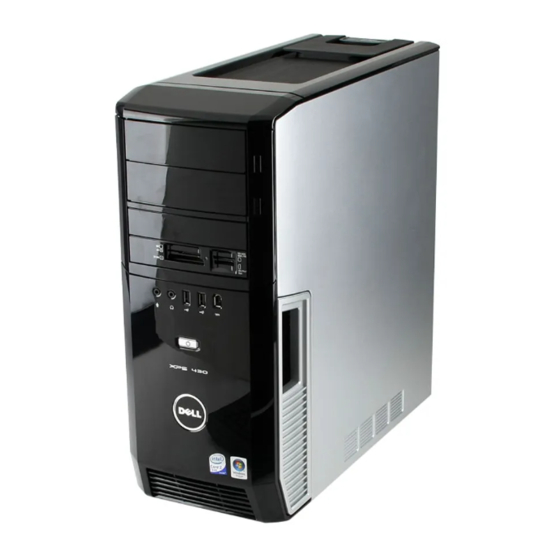Dell XPS 430 Panduan Servis - Halaman 36
Jelajahi secara online atau unduh pdf Panduan Servis untuk Desktop Dell XPS 430. Dell XPS 430 42 halaman. Dell xps computer setup
Juga untuk Dell XPS 430: Menyiapkan (2 halaman)

Boot Sequence
This feature allows you to set the order in which the BIOS will search devices when trying to find an operating system.
NOTICE:
If you modify any boot sequence settings, save the new settings to avoid losing the changes.
Option Settings
NOTE:
The computer attempts to boot from all bootable devices, but if no bootable device is found, the computer generates an error message that
states No boot device available. Press the <F1> key to retry the boot, or press the <F2> key to enter the setup utility.
USB Floppy Drive — The computer attempts to boot from the floppy drive. If there is no floppy drive connected to a USB port, the computer attempts to
l
boot from the next bootable device in the sequence.
NOTE:
If there is a non-bootable floppy in the drive, the computer generates an error message. Follow the instructions on the screen to retry the
boot.
Onboard SATA Hard Drive — The computer attempts to boot from the primary hard drive. If no operating system is on the drive, the computer
l
attempts to boot from the next bootable device.
Onboard or USB CD-ROM Drive — The computer attempts to boot from the CD drive. If no CD is in the drive, or if the CD has no operating system, the
l
computer attempts to boot from the next bootable device.
USB Device — Insert the memory device into a USB port and restart the computer. When F12 = Boot Menu appears in the upper-right corner of the
l
screen, press <F12>. The BIOS detects the device and adds the USB option to the boot menu.
NOTE:
To boot to a USB device, the device must be bootable. To ensure that your device is bootable, check the device documentation.
Changing Boot Sequence for the Current Boot
You can use this feature, for example, to restart your computer to a USB device such as a floppy drive, memory key, or CD-RW drive.
NOTE:
If you are booting to a USB floppy drive, you must first set the floppy drive to OFF in system setup (see
1. If you are booting to a USB device, connect the USB device to a USB connector (see "Front View of the Computer" in the Quick Reference Guide).
2. Turn on (or restart) your computer.
3. When F2 = Setup, F12 = Boot Menu appears in the upper-right corner of the screen, press <F12>.
If you wait too long and the operating system logo appears, continue to wait until you see the Microsoft Windows desktop, then shut down your
computer (see
Before You
Begin) and try again.
The Boot Device Menu appears, listing all available boot devices. Each device has a number next to it.
4. At the bottom of the menu, enter the number of the device that is to be used for the current boot only.
For example, if you are booting to a USB memory key, highlight USB Device and press <Enter>.
NOTE:
To boot to a USB device, the device must be bootable. To make sure your device is bootable, check the device documentation.
Changing Boot Sequence for Future Boots
1. Enter system setup (see
Entering System
2. Use the arrow keys to highlight the Boot Sequence menu option and press <Enter> to access the menu.
NOTE:
Write down your current boot sequence in case you want to restore it.
3. Press the up- and down-arrow keys to move through the list of devices.
4. Press the spacebar to enable or disable a device (enabled devices have a checkmark).
Do not report — Do not display any keyboard
l
errors.
Setup).
System Setup
Options).
